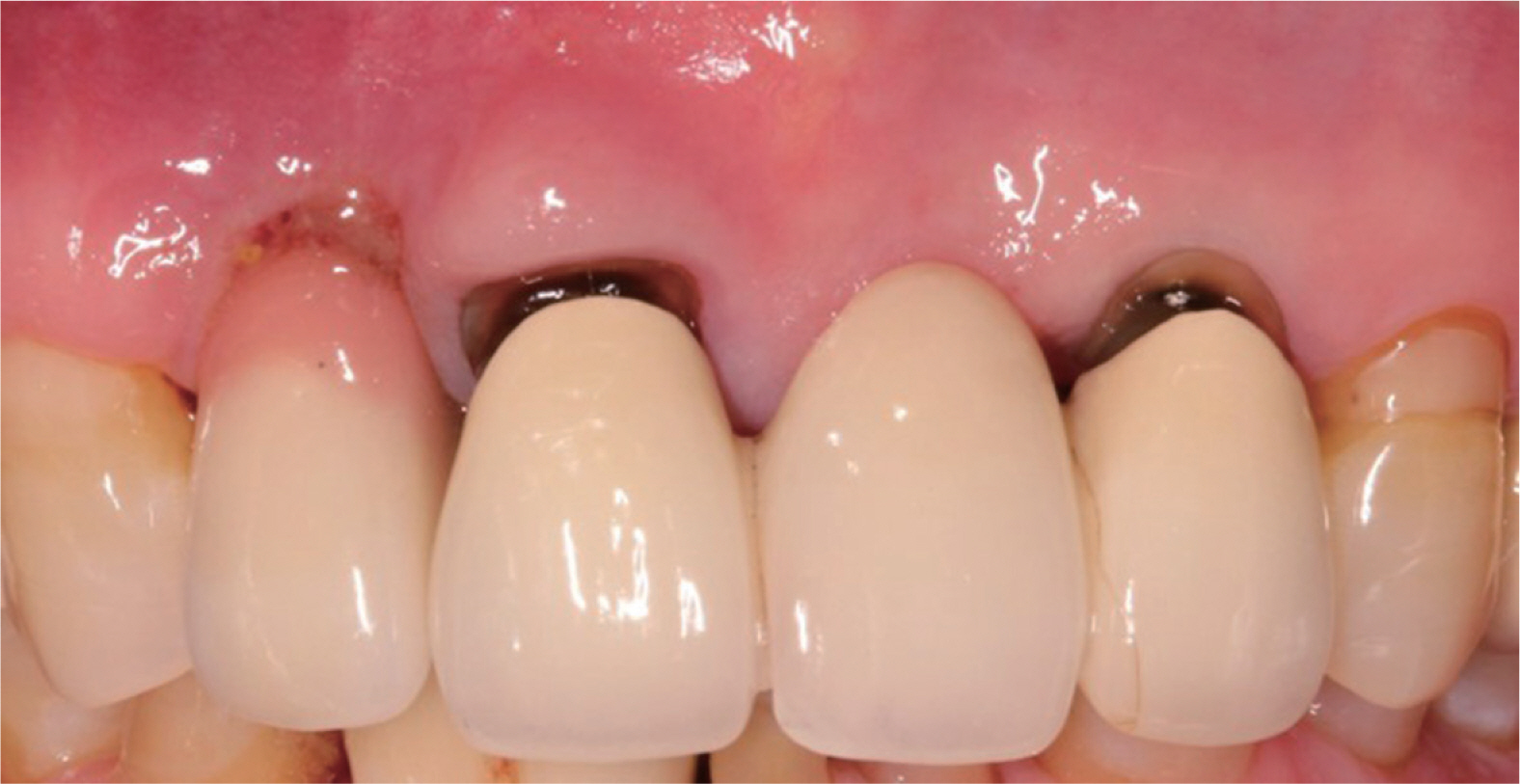J Dent Rehabil Appl Sci.
2020 Dec;36(4):289-295. 10.14368/jdras.2020.36.4.289.
Pontic site development with an implant submergence technique for unaesthetic implant in the anterior maxilla
- Affiliations
-
- 1Department of Periodontology, Pusan National University Dental Hospital, Yangsan, Republic of Korea
- 2Department of Periodontology, School of Dentistry, Pusan National University, Yangsan, Republic of Korea
- KMID: 2512124
- DOI: http://doi.org/10.14368/jdras.2020.36.4.289
Abstract
- Improving implant esthetics is very difficult, especially in cases where unaesthetic problems are related to implants in the maxillary anterior dentition. A 69-year old male patient was referred by a prosthodontist for periodic pus discharge and an unaesthetic implant prosthesis (maxillary right lateral incisor). The implant was placed too deeply and showed soft tissue volume deficiency and a long clinical crown. After a clinical and radiographic examination, implant submergence and alveolar ridge augmentation were performed to enhance the aesthetics instead of an explantation. The treatment plan was as follows: extraction the adjacent teeth with tooth mobility, secondary caries, and poor prognosis; placement an additional dental implant with hard and soft tissue grafting; fabrication a fixed bridge using implant abutments. A fixed esthetic prosthesis using implants was fabricated, and the patient was satisfied with the prosthesis. A ridge augmentation with implant submergence may be an alternative for solving the problems of unaesthetic implant restorations in the esthetic zone.
Figure
Reference
-
References
1. Mesquita de Carvalho PF, Joly JC, Carvalho da Silva R, González-Martín O. 2019; Therapeutic alternatives for addressing pink esthetic complications in singletooth implants: A proposal for a clinical decision tree. J Esthet Restor Dent. 31:403–14. DOI: 10.1111/jerd.12487. PMID: 31095876.2. Cooper LF, De Kok IJ, Thalji G, Bryington MS. 2019; Prosthodontic Management of Implant Therapy: Esthetic Complications. Dent Clin North Am. 63:199–216. DOI: 10.1016/j.cden.2018.11.003. PMID: 30825986.3. Buser D, Dula K, Belser UC, Hirt HP, Berthold H. 1995; Localized ridge augmentation using guided bone regeneration. II. Surgical procedure in the mandible. Int J Periodontics Restorative Dent. 15:10–29. PMID: 7591520.4. Grunder U. 2011; Crestal Ridge Width Changes When Placing Implants at the Time of Tooth Extraction With and Without Soft Tissue Augmentation After a Healing Period of 6 Months: Report of 24 Consecutive Cases. Int J Periodontics Rest. 31:9–17. PMID: 21365022.5. Comut A, Mehra M, Saito H. 2013; Pontic site development with a root submergence technique for a screw-retained prosthesis in the anterior maxilla. J Prosthet Dent. 110:337–43. DOI: 10.1016/j.prosdent.2013.06.009. PMID: 24035254.6. Papaspyridakos P, Chen CJ, Singh M, Weber HP, Gallucci GO. 2012; Success criteria in implant dentistry: a systematic review. J Dent Res. 91:242–8. DOI: 10.1177/0022034511431252. PMID: 22157097.7. Joo JY, Son S, Lee JY. 2016; Implant Site Development for Enhancing Esthetics of Soft and Hard Tissue and Simplification of Implant Surgery Using a Forced Eruption. Int J Periodontics Restorative Dent. 36:583–9. DOI: 10.11607/prd.2291. PMID: 27333017.8. Kan JY, Rungcharassaeng K, Lozada JL, Zimmerman G. 2011; Facial gingival tissue stability following immediate placement and provisionalization of maxillary anterior single implants: a 2- to 8-year followup. Int J Oral Maxillofac Implants. 26:179–87. PMID: 21365054.9. Buser D, Martin W, Belser UC. 2004; Optimizing esthetics for implant restorations in the anterior maxilla: anatomic and surgical considerations. Int J Oral Maxillofac Implants. 19 Suppl:43–61. PMID: 15635945.10. Evans CD, Chen ST. 2008; Esthetic outcomes of immediate implant placements. Clin Oral Implants Res. 19:73–80. DOI: 10.1111/j.1600-0501.2007.01413.x. PMID: 17956569.11. Funato A, Salama MA, Ishikawa T, Garber DA, Salama H. 2007; Timing, positioning, and sequential staging in esthetic implant therapy: a four-dimensional perspective. Int J Periodontics Restorative Dent. 27:313–23. PMID: 17726987.12. Chackartchi T, Romanos GE, Sculean A. 2019; Soft tissue-related complications and management around dental implants. Periodontol 2000. 81:124–38. DOI: 10.1111/prd.12287. PMID: 31407443.13. Mombelli A, Lang NP. 1998; The diagnosis and treatment of peri-implantitis. Periodontol 2000. 17:63–76. DOI: 10.1111/j.1600-0757.1998.tb00124.x. PMID: 10337314.14. Januário AL, Barriviera M, Duarte WR. 2008; Soft tissue cone-beam computed tomography: a novel method for the measurement of gingival tissue and the dimensions of the dentogingival unit. J Esthet Restor Dent. 20:366–73. DOI: 10.1111/j.1708-8240.2008.00210.x. PMID: 19120781.15. González-Martín O, Oteo C, Ortega R, Alandez J, Sanz M, Veltri M. 2016; Evaluation of peri-implant buccal bone by computed tomography: an experimental study. Clin Oral Implants Res. 27:950–5. DOI: 10.1111/clr.12663. PMID: 26178780.16. Singh G, O'Neal RB, Brennan WA, Strong SL, Horner JA, Van Dyke TE. 1993; Surgical treatment of induced peri-implantitis in the micro pig: clinical and histological analysis. J Periodontol. 64:984–9. DOI: 10.1902/jop.1993.64.10.984. PMID: 8277409.17. Kreisler M, Kohnen W, Christoffers AB, Götz H, Jansen B, Duschner H, d'Hoedt B. 2005; In vitro evaluation of the biocompatibility of contaminated implant surfaces treated with an Er : YAG laser and an air powder system. Clin Oral Implants Res. 16:36–43. DOI: 10.1111/j.1600-0501.2004.01056.x. PMID: 15642029.18. Wetzel AC, Vlassis J, Caffesse RG, Hämmerle CH, Lang NP. 1999; Attempts to obtain re-osseointegration following experimental peri-implantitis in dogs. Clin Oral Implants Res. 10:111–9. DOI: 10.1034/j.1600-0501.1999.100205.x. PMID: 10219130.19. Salama M, Ishikawa T, Salama H, Funato A, Garber D. 2007; Advantages of the root submergence technique for pontic site development in esthetic implant therapy. Int J Periodontics Restorative Dent. 27:521–7. PMID: 18092446.
- Full Text Links
- Actions
-
Cited
- CITED
-
- Close
- Share
- Similar articles
-
- A root submergence technique for pontic site development in fixed dental prostheses in the maxillary anterior esthetic zone
- Cases of screw-retained implant prosthesis in the anterior maxilla through multidisciplinary approach, including orthodontic teeth alignment
- Outcome Evaluation of an Immediately Placed Maxillary Anterior Single-Tooth Implant Using Objective Esthetic Criteria: Case Report
- The impact of the alveolar bone sites on early implant failure: a systematic review with meta-analysis
- Clinical study on survival rate of osseointegrated implants






